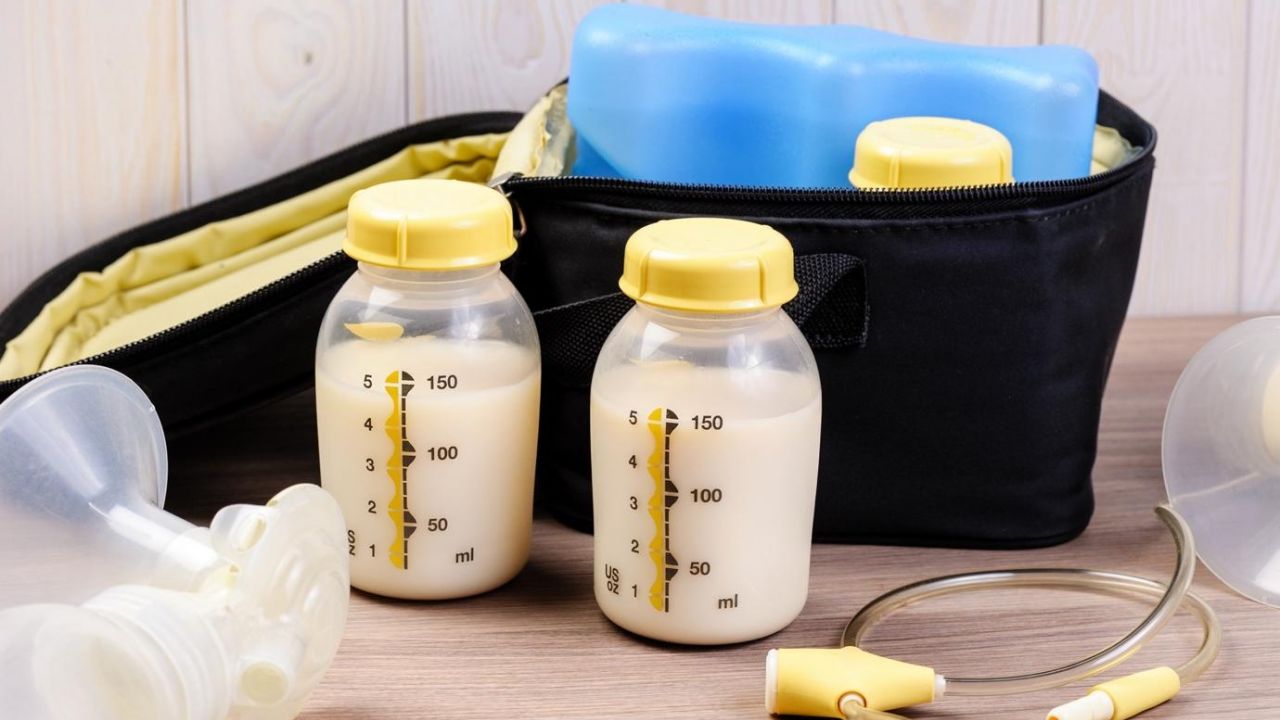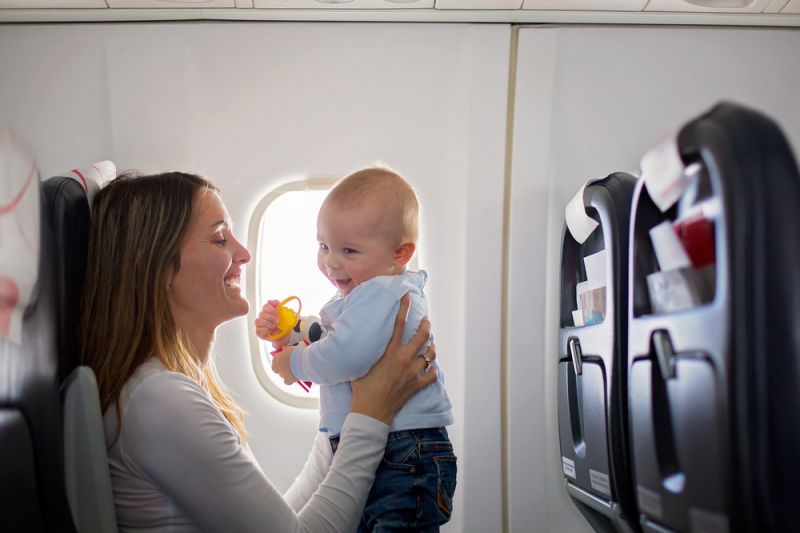
Flying with Breast Milk: Everything You Need to Know
Air travel presents its challenges, and for breastfeeding mothers, flying with breast milk and a pump is one such puzzle. From rules and regulations to practical tips, understanding how to fly with breast milk can make your journey smoother.
Here at AirAdvisor, we understand the unique considerations and challenges that come with air travel, especially for nursing mothers. In this article, we outline some regulations and policies regarding flying with breast milk, share some tips on how to practically prepare and package breast milk for flights and answer some frequently asked questions about flying with breast milk.
Learn how to get over a fear of flying.
How Much Breast Milk Can I Bring On an Airplane?
The quantity of breast milk you can bring onboard varies based on several factors, including the arrival and departure locations and the specific airline's rules for flying with breast milk. There technically aren’t any limitations to the quantity of breast milk in checked luggage, but for carry-on luggage, there are often limitations.
Below, you can review the general regulations surrounding breast milk in carry-on-luggage for the US, Canada, UK and European countries:
US Regulations
Breast milk is considered a medical necessity in the US and therefore has slightly more lenient rules compared to other liquids. When travelling with breast milk in the US, you're typically able to bring more than 100ml or 3.4 ounces of breast milk in your carry-on luggage, along with ice packs, frozen gel packs and other items that help you transport breast milk.
If you do bring more than 100ml of breast milk on board, you're required to inform a Transportation Security Administration (TSA) officer. The officer is likely to test the breast milk for concealed prohibited items and materials. The way TSA tests breast milk does not affect the nutritional or sanitary elements of breast milk.
People also read: what to do on a long flight.
Canada Regulations
The regulations surrounding breast milk onboard planes in Canada are essentially the same as regulations in the US. You're permitted to carry with you over 100ml of breast milk, provided you inform a screening officer before boarding. The regulatory body governing breast milk rules in Canada is the Canadian Air Transport Security Authority (CATSA)
UK Regulations
The regulations in the UK are slightly different to those in the US and Canada. When travelling in the UK, there's technically no limit to how much breast milk you can take. You're essentially limited by the weight capacity of your carry-on luggage. If your ticket allows you to have a total luggage weight of 40kg, you can technically take 40kg of breast milk with you.
When travelling with breast milk aboard UK flights, a single container can hold no more than 2,000ml. If you do take breast milk onboard the flight, expect to be screened at security checkpoints. Security officers may open and inspect the containers, particularly if you're carrying large quantities.
Europe Regulations
When travelling through European countries, you're typically allowed to carry more than 100ml of breast milk, provided the quantity is deemed 'reasonable'. This is a bit subjective and usually at the discretion of security officers. If a security officer believes you're carrying an overly excessive amount of breast milk, they may take action to remove and inspect your breast milk containers.
As with most countries, if you're travelling alone, the maximum amount of liquid you can take onboard is 100ml, so if you're not travelling with your child, you might not be able to bring as much.
If your flight was delayed, canceled or overbooked within the last 3 years, you could be eligible for up to ($650) €600 in compensation.Check Your Flight
How to Pack Breast Milk When Flying?
Packing breast milk properly before flying is of paramount importance to ensure the safety, quality and nourishment of breast milk. If not packed properly, there are several things that could go wrong. Your container may leak and the contents may become contaminated or spoiled during transit.
Did you know which items are not allowed in a hand luggage?
Below, you can review some steps on how to pack properly when traveling with breast milk:
- Use Sterile Containers: Choose breast milk storage containers that are clean and sterilised. Glass containers or hard plastic bottles are often suitable. Also, make sure they're tightly sealed and leak-proof.
- Pre-cool Containers: Before you store breast milk in containers, consider cooling them in the refrigerator. This prevents condensation inside the container, which could potentially introduce moisture and affect the milk's quality.
- Bag Individual Containers: Place each breast milk container inside individual ziplock bags. The milk storage bags provide an extra layer of protection against leaks and ensures that if one container does leak, it won't affect the rest of your belongings.
- Pack in an Insulated Cooler Bag: Consider investing in a good-quality insulated cooler bag with ice packs. These bags help maintain a consistent temperature, keeping the breast milk cool throughout your journey.
- Layering Technique: To distribute the cold evenly and maintain a low temperature in the cooler bag, consider arranging the breast milk containers in layers, alternating with ice packs.
- Monitor Temperature: During your trip, periodically check the temperature of the breast milk and the ice packs. If the frozen ice packs begin to thaw, consider asking the flight attendants for additional ice to maintain the temperature.
- Keep Easily Accessible: Place the cooler bag with breast milk in an easily accessible part of your carry-on luggage. This allows you to quickly retrieve it during security checks or if your baby needs feeding during the flight.
- Use the Milk Promptly: This isn't necessarily a tip for flying, but once you arrive at your destination, refrigerate or use the breast milk as soon as possible. Non-frozen breast milk has a shorter shelf life compared to frozen milk, so it's important to follow proper storage and usage guidelines.
- Follow Airline Guidelines: Always check the specific guidelines of the airline you're flying with to ensure you're in compliance with their rules for carrying breast milk.
Flight delayed over 3 hours or canceled? See if AirAdvisor can get you compensation.Check Your Flight
How to Pack Frozen Breast Milk?
Packing frozen breast milk for air travel might require a bit more planning to maintain its frozen state and ensure its safety for your baby's consumption. Here's a guide on how to pack when flying with frozen solid breast milk:
- Use Sturdy Containers: Choose freezer-safe breast milk storage containers. Avoid using glass containers as they might break during travel when frozen. Double-check that the containers are tightly sealed to prevent leaks.
- Freeze Ahead of Time: Ideally, freeze your breast milk at least 24 hours before your departure. This ensures that it's completely frozen and will stay colder longer.
- Pre-Cool Cooler Bag: Pre-chill your insulated cooler bag with ice packs before packing the frozen breast milk. This helps maintain a consistently cold environment.
- Pack with Ice Packs: Place the frozen breast milk containers within the cooler bag, layering them with freezer packs, similar to the layering technique for packing non-frozen breast milk. This will keep your breast milk frozen for longer.
- Use Dry Ice (If Needed): While perhaps a bit excessive, you can also use dry ice instead of a regular ice pack to maintain the temperature of breast milk. If you're carrying a large amount of frozen breast milk or travelling for an extended period, this might be helpful. Check with your airline, though, as policies on dry ice quantity and packaging requirements can vary.
- Keep Essentials Accessible: Just like packing non-frozen breast milk, it's usually helpful to have your cooler bag in an easily accessible part of your carry-on luggage. This facilitates quick retrieval during security checks or adjustments to ice packs during the flight.
- Monitor Temperature: Periodically check the condition of the breast milk and the ice packs during the flight to ensure they're maintaining a consistent temperature.
- Store Upon Arrival: Upon reaching your destination, transfer the frozen breast milk to a freezer as soon as possible to maintain its quality.
- Follow Airline Regulations: Always check the specific guidelines of the airline you're flying with regarding carrying frozen breast milk, as some airlines might have specific policies.
Find out how far in advance to book a flight.

How do I Pass with Breast Milk Through Airport Security?
For many countries and airports, the procedure for passing breast milk through security checkpoints is relatively standard. In general, if you're carrying more than 100ml of breast milk onto a flight, or breast pumps, you're required to declare it at security checkpoints. The security officers may ask to inspect your containers and the rest of your carry on baggage to ensure there's no trace of prohibited substances, materials or items hidden within.
Security officers at airports perform a non-invasive screening process, so you don't need to worry about contamination or spoiling during screening. A tip to consider when flying with breast milk is to ensure you facilitate enough time for additional security screening. Passing through security checkpoints can take additional time, so incorporating this into your journey can help ensure a smooth trip.
Check out our general rules and tips on food you can bring through TSA.
Find out if you are owed compensation for a disrupted flight.Check Your Flight
How to Pack Breast Milk In My Checked Luggage?
Storing breast milk in your checked luggage essentially involves the same steps as storing it in your carry-on luggage, except you won't have an opportunity to inspect your containers mid-flight. For this reason, it's important to ensure you use a sturdy container that won't leak, ample ice packs and zip-lock bags to store the containers.
You might also check the regulations of the airline you're flying with regarding packing breast milk in checked luggage. Some airlines may have specific guidelines or restrictions.
Should I bring Breast Milk or Pump on the Plane?
The answer to this question is subjective, as it depends on the circumstance of your journey. Breast milk has its advantages, like less equipment and general convenience. But, it also has some downfalls, like storage challenges, security checks and limited quantity.
For a breast pump, you're not necessarily restricted by quantity regulations, which may be helpful for those longer journeys across various countries. You also don't need to worry about storage mishaps, like leaks, thawing and contamination. On the other hand, though, you have pumping gear to consider and pumping breast milk on a plane isn't always the most private of activities.
How long can I travel with breast milk?
How long your breast milk lasts depends on many factors, like whether it's fresh or partially frozen breast milk. It can also depend on the temperature onboard. A rough guideline may be 2-3 hours for fresh breast milk and 24 hours for refrigerated and frozen breast milk. This is only a rough guideline, though, as many factors can influence the duration. Also, you should be aware that sometimes flights can get delayed or even cancelled. In the event of a delayed flight you might also be eligible for compensation.
FAQs
Below, you can explore some frequently asked questions about flying and breast milk storage guidelines:
Can I bring breast milk on an airplane?
Yes, you can. The quantity of breast milk you carry is dependent on the country and airline, but breast milk is usually allowed onboard.
Can breast milk go through an X-ray at the airport?
Typically, yes. X-ray machines at airports are often not powerful enough to alter the nutritional and compositional state of breast milk. If you don't want this screening process, you can usually inform the security officer and they can conduct alternative testing.
No feedback
Leave your feedback


Flight Compensation Calculator:
Check if you are entitled to flight delay compensation in just 3 minutes.